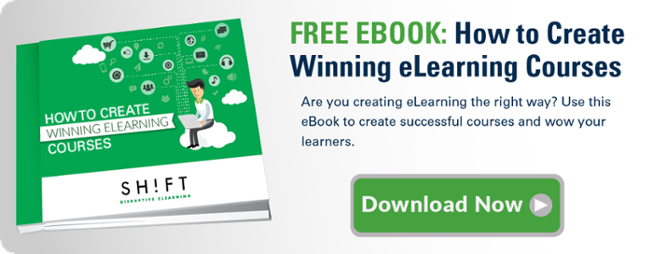 As you build your eLearning courses, it’s important not only making sure you’re keeping your learner’s interest and that you’re keeping them motivated, but also that you’re getting out the best outcome. You need an engagement plan! Use the ENGAGE model as your guide.
As you build your eLearning courses, it’s important not only making sure you’re keeping your learner’s interest and that you’re keeping them motivated, but also that you’re getting out the best outcome. You need an engagement plan! Use the ENGAGE model as your guide.
What makes an experience engaging?
An eLearning experience is likely to be engaging if one or more of the following is true:
- There is some type of challenge involved.
- Learners must make decisions and explore.
- Learners can make mistakes.
- Learning is fun.
Why engagement is necessary in eLearning?
Too many time we encounter eLearning courses that are “page-turners”, where learners simply read through heavy-text screens. Engaging eLearning courses are necessary because they help keeping learners interested and mentally stimulated till the end of the course.
What is the ENGAGE Model?
The Engage Model is a method for designing learning that drives action, while also delivering results. This new six-step model was originally designed by Vicki Hasley to revolutionize traditional workplace learning. But, we think this new model can also revolutionize eLearning training sessions. Ultimately, the goal of this model is to get learners truly engaged and connected.
E: Energize learners. Energize and focus your learners early and often throughout the session.
N: Navigate content. Have students personally experience some aspect of what you are trying to teach. Focus less on what you are presenting and more on how you present it.
G: Generate meaning. Generate meaning by asking students what they've learned and how does it make a difference in their lives. This step emphasizes relevance and encourages people to turn knowledge into action.
A: Apply to the real world. Relate what they have learned in the real world by allowing them to practice it.
G: Gauge and celebrate. Assess how much students have learnered. But go beyond that, celebrate and recognize those achievements in fun and interactive ways.
E: Extend learning to action by helping your students act on their intentions. This means take learning to action by guiding students in their tasks.
How to implement the ENGAGE Model:
Ready to launch your first course based on the ENGAGE MODEL? Follow these 5 steps, and you'll reap the benefits of a successful and engaging eLearning course!
Step 1: Get to know your audience
Take time to study the characteristics of your target audience: interests, expectations, skills, prior knowledge, how they learn, among others. In order to stimulate curiosity and stir up desire from the very start, you need to know whom you’re talking to.
Step 2: Present relevant content
Once you’ve established the profile of your learners, define the content of the course considering their interests and needs. Make eLearning courses crisp with relevant content. Remove any unnecessary content so that the learners can remember only the important features. At the end of the training, students should have acquired new knowledge or skills that they can apply in their daily work.
Step 3: Integrate review and practice activities
Follow the progress and performance of students during their training through review activities. To make it even more engaging, include games, simulations and knowledge checks. Remember, if you want engaged eLearners, they must see the value of your assessments and they must spot that importance quickly.
Step 4: Include case studies, scenarios and examples
Real-life cases must be included throughout the course. Provide examples, illustrations and success stories (and also negative ones) that support your content. Using testimonials or showing a problem that reminds participants about why they should care is a great way to start. For deeper learning, have learners involved in Real-Life Scenarios. Afterwards, ask students to use their new skills to solve the problem.
Step 5: Simplify the course navigation
Having a clear navigation where learners intuitively know where they are and where they should go is key. Include instructions and buttons to facilitate these navigation journey.
Step 6: Support
One of the most important motivational factors in eLearning is to provide students with material to use once the course is over. Help learners review and reengage by directing them to an online community where they can comment on what the course taught or by providing handy cheat sheets to refer to as they apply new information at work.
Roundup: We encourage you to create courses where students don’t just passively receive information. Make the courses active and thought-provoking. It’s all about how the learner interacts with the content. Do not wait anymore... apply the ENGAGE model and get the best from your students! That's all there is to it! Once you notice that your learners are coming back for more, you can be sure you were successful engaging them.




